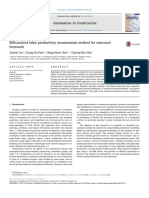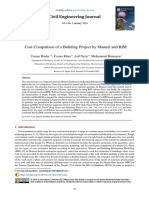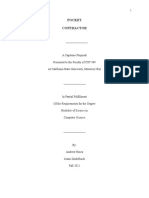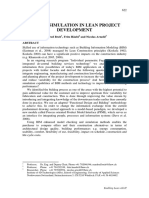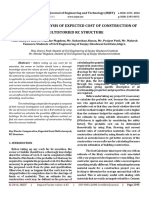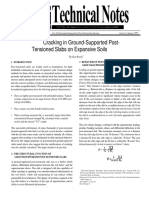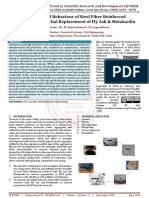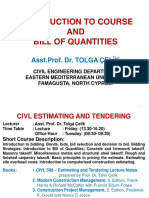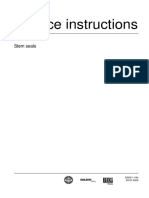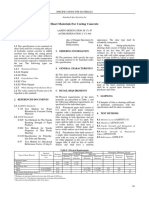Professional Documents
Culture Documents
Development of Computer Aided Model For Digital Estimation of Building Materials and Civil Engineering Quantities
Original Title
Copyright
Available Formats
Share this document
Did you find this document useful?
Is this content inappropriate?
Report this DocumentCopyright:
Available Formats
Development of Computer Aided Model For Digital Estimation of Building Materials and Civil Engineering Quantities
Copyright:
Available Formats
Volume 7, Issue 5, May – 2022 International Journal of Innovative Science and Research Technology
ISSN No:-2456-2165
Development of Computer Aided Model for Digital
Estimation of Building Materials and Civil
Engineering Quantities
Abayomi, Oluwajuwon Debola, Akinkuolie, Bisola Oluwaseun, Oguntelure, Temitope Elizabeth and Ubalua, Okechukwu Charles
Department of Civil Engineering, Federal University of Technology Akure, PMB 704, Ondo State, Nigeria.
Abstract:- Over the years, there have been ineffective Estimating of quantities and cost in building and civil
and inaccurate results being noticed to have been gotten engineering works is a very complex task to undergo,
over time when bill of civil and engineering quantities are because it requires a careful and full understanding of the
computed manually. However, with the aid of a construction methods and construction materials to get a
developed software package in calculating the bill of reasonable forecast due to the uncertainty in the price of item
quantities, effective and efficient results would be gotten. to be used for a construction project as a result of
From the foregoing this study aims at developing a environmental change, change in political environment,
computer aided model to digitally compute building and price trend as well as change in technological demand of
civil engineering quantities using C# programming goods and services, estimating of quantities and cost of
language. The approach used in this study is developing construction work as proven to be very complex, full of
the digital computation program and testing the errors and time consuming (Oluyemi, 2016). These days,
computational program using the manual taking off Information and Communication Technology (ICT) is
from both residential building and road plans to validate responsible for the entire construction process from
the software. The results obtained from this study information being generated, transmitted and interpreted
indicate that, with reference to the residential building to enabling the project to be built, maintained and eventually
plan, 100% of the substructure items found in the bill fall recycled (Ikechukwu et al.,2011). Although communication
within 0 to 0.05 percentage difference and 75% of the is an essential value in construction projects, the construction
superstructure items have 0 to 0.4 percentage industry is confronted with the importance and use of
differences. In road plan, 100% of the items in site information and communication technology (ICT). As most
clearing and earthworks (Bill no. 2) have 0 percentage firms in developed countries have increased and will
differences, while 86% of the items in bill no. 3 ( increase further their investment in ICT, this has raised
drainage and culverts) have 0 percentage differences. productivity within their construction industry and resulted
All items in bill no.4 (Pavement and surfacing) have 0 in an increase in the quality and speed of work, financial
percentage differences between the manual and digital controls, communications, and access to common data.
computation. Since there are little or no difference in Firms in the third world countries are yet to understand this
the result obtained from manual computation and essential value and its importance to the development of their
digital computation. Therefore, the developed digital construction sector (Ikechukwu et al., 2011).
computation program is efficient and reliable and can be
used in lieu of the manual estimation. This study aims to develop application software by
using C# programming language for the measurement and
I. INTRODUCTION quantification of building and civil engineering works by
validating the software and comparing the results with
The recent development in the computer field, and the manual computation.
evolution of powerful and affordable microcomputers which
now out-perform old minicomputers have created great II. AIM AND OBJECTIVES
potential for their use in the building and civil engineering
industries. Computing is a very essential application in our The aim of this research is to develop application
day-to-day activity. Also, computing has come a long way software for the measurement and quantification of building
in enhancing excellent results in engineering applications. and civil engineering works.
Introducing the concept of computing to all professions has The objectives are to:
been a tremendous step in ensuring effective output/results review the concept of quantity estimation.
for every input. In addition, the proliferation of construction develop application software using Microsoft Visual
related software has resulted in the development of more SEE-SHARP (C#) programming language for digital
efficient decision support systems for the management of computation and
both the construction company and its construction sites. evaluate the software for suitability, reliability and
recommend accordingly.
IJISRT22MAY487 www.ijisrt.com 293
Volume 7, Issue 5, May – 2022 International Journal of Innovative Science and Research Technology
ISSN No:-2456-2165
III. MATERIALS AND METHODS Cost Estimate
Cost estimating is a fundamental ingredient for budgeting
Materials Used and preparation of bid for any construction project. A good
In the course of this research, the materials used are: estimate depends on many factors including time given to
Microsoft Visual C# software. the estimator, estimator’s experience, and a wide range of
Building plan and construction processes. assumptions regarding the project. Construction cost
Road plan and construction processes. estimating involves collecting, assaying, and recapitulating
all available data for a construction project.
Methods
The method adopted in the development of the A construction cost estimate is a vaticination of the
software can be divided basically into two: total cost of a construction project. It is the estimator’s
developing the digital computation program and responsibility to help the owner of the project to plan and
testing the computational program budget for the construction of the project.
Bill Of Quantities Odays Technologies Associated For Detailed Cost
A bill of quantities (sometimes referred to as a 'BoQ' or Estimate
'BQ') is a document, typically prepared by a cost consultant As one can see, detailed cost estimating is a clumsy
(often a quantity surveyor) that provides measured quantities process that involves a lot of data and calculations. Today’s
of the items of work identified by the drawings and estimating technologies include, but are not limited to,
specifications in the tender documentation for a project. It is spreadsheets, cost estimating software, digitizing tablets, on-
issued to tenderers for them to prepare a price for carrying screen digitizing systems, and the yet to be matured 3-D
out the works. CAD parametric estimating software (Samphaongoen,
2010).
Manual estimating can be an inefficient use of time,
and so cost consultants often use BoQ software packages to
make the process easier and to reduce errors. Databases may Programming Language
already exist providing design information from a building Coded language used by programmers to write
model, and specifications, and so quantities can be instructions that a computer can understand to do what the
calculated and tender documents generated. During the programmer (or the computer user) wants. The most basic
design process, new measurements can be filed and (called low-level) computer language is the machine
included, with the result that every item, as well as the totals, language that uses binary („1‟ and „10‟) code which a
is updated automatically. computer can run (execute) very fast without using any
translator or interpreter program, but its tedious and
Elbetalgi (2014) indicated that the objective of complex. The high level languages (such as basic, c, java)
preparing the Bill of Quantities is to assist estimators to are much simpler (more English like) to use but need to use
produce an accurate tender efficiently and to assist the post another program (a complier or an interpreter) to convert the
contract administration to be carried out in an efficient and high-level code into the machine code, and are therefore
cost-effective manner. It should be noted that the quality of slower.
the drawings plays a major part in achieving theses aims by
enabling the taker-off to produce an accurate bill and also by There are dozens of programming languages and new
allowing the estimator to make sound engineering judgments ones are being continuously developed (programming
on methods of working. language, 2016). Also called computer language, the
computer language used in this project is a C# programming
language.
IJISRT22MAY487 www.ijisrt.com 294
Volume 7, Issue 5, May – 2022 International Journal of Innovative Science and Research Technology
ISSN No:-2456-2165
Fig 1: An excerpt of the graphical interface in C# environment
Fig 2: Computerized design of digital computation
Fig 3: Computerized design for checks
IJISRT22MAY487 www.ijisrt.com 295
Volume 7, Issue 5, May – 2022 International Journal of Innovative Science and Research Technology
ISSN No:-2456-2165
Fig 4: Validated output for checks
Application Flow Chart
Fig 5: A Flow Chart Diagram Illustrating step by step process of the Building Program
IJISRT22MAY487 www.ijisrt.com 296
Volume 7, Issue 5, May – 2022 International Journal of Innovative Science and Research Technology
ISSN No:-2456-2165
IV. RESULTS AND DISCUSSION building materials and civil engineering quantities to ease
the rigor of quantity estimation. In the course of execution
The methodology adopted in accomplishing the aim of of the computer program, ease-of use and flexibility was a
this project involves two steps; developing and validating major consideration.
the computational program. The process of validating the
computational program in order to measure the efficiency of The developed program was validated using a proposed
the digital estimation of building materials and civil residential development at Sunshine estate, Oba Ile, Akure,
engineering quantities followed the same style and Ondo State and an assumed road plan. The table 1 below
procedure normally used in a manual calculation. With this shows the draft billing obtained from the manual
package, one can slot in any value provided the value falls computation of the proposed building while table 2 shows
within the validity of the model of the program. The the draft billing obtained from the digital computation of the
result obtained from the implementation of this study is the proposed building.
development of a rational procedure for the estimation of
Table 1: Draft Bill Obtained From the Manual Computation of the Proposed Building
SUBSTRUCTURE
ITEM DESCRIPTION QUANTITY UNIT
A Site Clearing 229.00 m2
B Top Soil Removal 183.30 m2
C Trench Excavation 88.20 m3
D Level and Ram 73.49 m2
E Foundation Blinding 73.49 m2
F Foundation Concrete 16.91 m2
G Foundation Block work 129.70 m2
H Backfilling 49.72 m3
I Cart away 79.98 m3
J Laterite Filling 43.35 m3
K Hardcore 43.35 m
L DPM and BRC Mesh 73.50 m2
M Formwork for Oversite 54.00 m2
N Concrete Slab 25.60 m3
SUPERSTRUCTURE
ITEM DESCRIPTION QUANTITY UNIT
A Block wall 225.00 m2
B Lintel Concrete 2.25 m3
C Formwork for Lintel 9.94 kg
D Reinforcement 388.40 kg
Table 2: Draft Bill Obtained from the Digital Computation of the Proposed Building
SUBSTRUCTURE
ITEM DESCRIPTION QUANTITY UNIT
A Site Clearing 229.00 m2
B Top Soil Removal 183.30 m2
C Trench Excavation 88.00 m3
D Level and Ram 73.40 m2
E Foundation Blinding 73.40 m2
F Foundation Concrete 73.40 m2
G Foundation Block Wall 129.70 m2
H Backfilling 50.00 m3
I Cart away 79.98 m3
J Laterite Filling 43.35 m3
K Hardcore 43.35 m
L DPM and BRC Mesh 73.50 m2
M Formwork for Oversite 54.00 m2
N Concrete Slab 26.00 m3
IJISRT22MAY487 www.ijisrt.com 297
Volume 7, Issue 5, May – 2022 International Journal of Innovative Science and Research Technology
ISSN No:-2456-2165
SUPERSTRUCTURE
ITEM DESCRIPTION QUANTITY UNIT
A Block wall 225.00 m2
B Lintel Concrete 2.20 m3
C Formwork for Lintel 9.90 Kg
D Reinforcement 388.40 Kg
Table 3: Comparison of Draft Bill Results for the Proposed 3-bedroom flat at Oba Ile, Akure, Ondo State.
SUBSTRUCTURE
MANUAL DIGITAL
COMPUTATION COMPUTATION
ITEM DESCRIPTION QANTITY/UNIT QUANTITY/UNIT DIFFERENCE % DIFFERENCE
A Site Clearing 229.00 m2 229.00 m2 0.00 0.00
B Topsoil Removal 183.30 m2 183.30 m2 0.00 0.00
C Trench Excavation 88.20 m3 88.22 m3 0.02 0.02
D Level and Ram 73.40 m2 73.40 m2 0.00 0.00
E Foundation Blinding 73.40 m2 73.40 m2 0.00 0.00
F Foundation Concrete 73.40 m2 73.40 m2 0.00 0.00
G Foundation Block work 129.70 m2 129.70 m2 0.00 0.00
H Backfilling 49.72 m3 49.73 m3 0.01 0.02
I Cart away 79.98 m3 79.98 m3 0.00 0.00
J Laterite Filling 43.35 m3 43.35 m3 0.00 0.00
K Hardcore 43.35 m 43.35 m 0.00 0.00
L DPM and BRC Mesh 73.50 m2 73.50 m2 0.00 0.00
M Formwork for Oversite 54.00 m2 54.00 m2 0.00 0.00
N Concrete Slab 25.60 m3 25.60 m3 0.00 0.00
SUPERSTRUCTURE
MANUAL DIGITAL
COMPUTATION COMPUTATION
ITEM DESCRIPTION QUANTITY/UNIT QUANTITY/UNIT DIFFERENCE % DIFFERENCE
A Block wall 225.00 m2 225.00 m2 0.00 0.00
3
B Concrete in Lintel 2.25 m 2.20 m3 0.05 2.27
C Formwork for Lintel 9.94 kg 9.90 kg 0.04 0.40
D Reinforcement (12mm) 388.40 kg 388.40 kg 0.00 0.00
The result shown in table 3 can be summarized as dynamically interactive. The application has the capability
follows; to accept, run, perform, execute and give the final answers to
numerical iteration method adopted, thereby computing
Substructure- 100% of the 14 items found in this quantities and costs.
bill fall within 0 to 0.05 percentage difference.
The results obtained indicate that substructure has
Superstructure- 75% of the items has 0 to 0.4 100% of the 14 items found in this bill falls within 0 to 0.05
percentage difference. From the summary above, the result percentage difference, Superstructure 75% of the items have
shows that there are little or no difference in the final outputs 0 to 0.4 percentage difference. Also, from Bill no.2, site
of the quantities obtained through the manual clearing and earthworks, 100 percent of the items in this bill
computation and the digital computation for the project. have 0 percentage difference, Bill no.3 drainage, 86% of
Therefore, the developed digital estimation program can the items in this bill has 0 percentage difference and 14%
be said to be efficient and accurate in its final outputs and has 1.354 percentage differences in it.
can be used in place of manual computation with its other
advantages. Therefore, it is recommended to use the application
software developed using a combination of Microsoft visual
V. CONCLUSION AND RECOMMENDATION C SHARP (C# version 2012) and Microsoft visual studio
Environment (version 2012) as it is proven to have the
The development of the software was achieved using a following:
combination of good programming Microsoft visual C The developed program will solve the problem of fatigue
SHARP (C# version 2012) and Microsoft visual studio and limit potential errors in quantity estimation and bill
Environment (version 2012), which allows an artistic preparation as well as reduce the time consumed.
application to be created, visually appealing and The program was designed in such a way that the users
IJISRT22MAY487 www.ijisrt.com 298
Volume 7, Issue 5, May – 2022 International Journal of Innovative Science and Research Technology
ISSN No:-2456-2165
will be guided through the computation stages in a [21]. technology in the construction industry‟, American
straight forward and understandable manner as it is Journal of Scientific and Industrial Research, 2(3), pp.
visually appealing and dynamically interactive. 461-468.
Improves the accuracy and reliability of cost estimation. [22]. Jagun, S.O. (2003). Use of Information Technology in
Reduces the manual work necessary for preparing an Project Management in Nigeria: The
estimate [23]. state of the art. Master in Project Management Project
report, Department of Building University of Lagos,
REFERENCES Nigeria
[24]. Kwok, K. (2007). Model based estimating system for
[1]. Achenu, E. (1999) “Computer Applications in the civil concrete structures “Research on
Building Industry in Jos and Abuja”, Nigeria Journal [25]. Automated estimating for Civil concrete structures”.
of Environmental Sciences, 3(2), 1999, pp. 239-244. Cooperative Research Centre for Construction
[2]. Aderinola, O. (2016) Quantity surveying [lecture note Innovation, George St,.Australia.
to B.Eng. Civil & environmental engineering, year 5 [26]. Li, H. (1996). Selecting KBES developing techniques
students], CVE 517: Federal university of technology, for applications in the construction industry.
Akure. Construction Management and economics. 14, 67-74
[3]. Aderinola, O. and Olaoye, T. (2014) „Development of [27]. Montes,V, Falcon,R and ramirez, A. (2014).
Digital Computation of Building and „Estimating Building Construction Costs by Production
[4]. Civil Engineering quantities‟, American journal of Processes‟, Open Construction and Building
Engineering Research, 03 (06), pp.199-208. Technology Journal, pp 171-181
[5]. Ayeni,A. A. (1989). Computers: Making your choice. [28]. Oluyemi, B. (2016) Building Technology [lecture
Lagos Q.S. Digest 3(2) ,4-5,14 note to B.Eng civil & environmental engineering, year
[6]. Cartlidge, D. (2002). New Aspects of Quantity 5 students], CVE 507: Federal University of
Surveying Practice. Oxford: Butterworth Heinemann technology, Akure.
[7]. Cheng, M., Hsing-Chih, T, and Eruk, S. [29]. Oni O. M. (2003). Information Technology and the
(2009).‟Conceptual cost estimates using evolutionary Procurement process in the Nigerian
fuzzy hybrid neural network for projects in [30]. Construction Industry: use impact and strategy. M.Sc
construction industry‟, Department of Construction project report, Department of Building, University of
Engineering, National Taiwan University of Science Lagos, Nigeria.
and Technology, a. 37 (2010), pp. 4224–4231. [31]. Oyediran O. S. and Odusami, K.T. (2004). Whither the
[8]. Choi, Y. (2004). Principles of Applied Civil Nigerian Quantity Surveyors in the Information
Engineering Design. New York: American Technology Age. An International Journal of
[9]. Cost Estimating Process and Practices. Upper Saddle Information and Communication Technology (ICT). 1
River: Prentice Hall, 2005.Print. Cost Estimating (1 & 2) 1-16.
Process and Practices. Upper Saddle River: Prentice [32]. Pollack-Johnson, B. and Liberatore, M. J. (1998).
Hall, 2005. Project management Software Usage, patterns and
[10]. Cunningham, T. (2014). An introduction of building Suggested Research Directions for Future
quantities: an Irish approach paper 30, Developments. Project Management Journal. 29 (2),
[11]. Dublin institute of technology. 19-28.
[12]. EbenSaleh, M., and Ravinder, R. (1998): A computer [33]. Rivard, H.; Froese, T.; Waugh, L. M..; El-Diraby T.;
program for calculating the bill of Mora, R; Torres, H.; Gill, S.M.. & Construction
[13]. quantities from AutoCAD drawings (revised version). Industry, ITcon, Vol 2, pg. 19-34, at
Coll. of Arch. and Plng, King Saud University, Riyadh, http://www.itcon.org/2004/2/
Saudi Arabia. [34]. Samphaongoen, P. (2010) "A Visual Approach to
[14]. Ekwueme, A. (1997).Computer Applications in Construction Cost Estimating"
Construction Management. Unpublished [35]. Seeley, I. H. (1993). Civil Engineering Quantities. 5th
[15]. B.Sc. Thesis, Building Department, University of Jos. edition UK: Macmillian Press Ltd.
Pp. 1 - 120. [36]. Shash, A.A. and Al-mir, M. (1997). Information
[16]. Eite, R.P. (1982). A private practice's Computer. The Technology in Contractors firms in Saudi Arabia.
Quantity Surveyor. 28 (10) Construction Management and Economics. 15, 187-
[17]. Elbeltagi, E. (2009) Cost Estimating. First edition, 200.
Egypt, Mansoura University press. [37]. UNESCO revitalization project (2008) principle of
[18]. Honey R. (1998). Make IT a fundamental part of our construction economics [lecture note to National
business. Chartered Surveyor Monthly February 57 diploma quantity surveying year 2 students] QUS 101
[19]. Howard. R, Kiviniemi, A. & Samuelson, O. (1998). and QUS 207; Nigeria technical &vocational
Surveys of IT in the Construction Industry and education.
experience of the IT Barometer in Scandinavia. ITcon,
Vol 3, pg. 45-56, at http://www.itcon.org/1998/4
[20]. Ikechukwu O. Chinedu, C. and Onyegiri, J. (2011).
„Information and communication
IJISRT22MAY487 www.ijisrt.com 299
You might also like
- VP Task 3. NewwDocument40 pagesVP Task 3. NewwRidhwan KnwNo ratings yet
- Computer Applications in ConstructionDocument32 pagesComputer Applications in ConstructionLhester Navasca100% (1)
- Piping Design in Detailed EngineeringDocument4 pagesPiping Design in Detailed Engineeringmaneeshmsanjagiri0% (1)
- Construction Cost Estimation SystemDocument5 pagesConstruction Cost Estimation SystemURBANHIJAUNo ratings yet
- Comparative Cost Estimation of ResidentiDocument7 pagesComparative Cost Estimation of ResidentiSamiullah M QaisraniNo ratings yet
- Lee 2020 IOP Conf. Ser. Mater. Sci. Eng. 943 012058Document8 pagesLee 2020 IOP Conf. Ser. Mater. Sci. Eng. 943 012058Name UserNo ratings yet
- Assignment: Computer ProgrammingDocument14 pagesAssignment: Computer ProgrammingSharjeel GillNo ratings yet
- Bim Assisted Labor Productivity Measurement Method For Structural FormworkDocument12 pagesBim Assisted Labor Productivity Measurement Method For Structural FormworkBirukNo ratings yet
- Impact of Tech Advancements in Construction Project ManagementDocument8 pagesImpact of Tech Advancements in Construction Project ManagementJoanne IcaroNo ratings yet
- Software Cost Estimation Models and Techniques A Survey IJERTV3IS20384Document6 pagesSoftware Cost Estimation Models and Techniques A Survey IJERTV3IS20384balj balhNo ratings yet
- Pradeep Mini Project-1Document11 pagesPradeep Mini Project-1Pradeep BodireNo ratings yet
- BIM FulltextDocument69 pagesBIM FulltextSindhuja SharavanNo ratings yet
- IoT Facilitates Construction Teams in Delivering Projects on TimeDocument17 pagesIoT Facilitates Construction Teams in Delivering Projects on TimeWan HaziqNo ratings yet
- Irjet V5i12327Document7 pagesIrjet V5i12327Khusnul khotimahNo ratings yet
- Information Technology in Civil Engineering: Introduction - Ceng 116B Database Management in ConstructionDocument26 pagesInformation Technology in Civil Engineering: Introduction - Ceng 116B Database Management in ConstructionRalph CrucilloNo ratings yet
- Professional Practice Information Notes Note 3: Integrated PracticeDocument8 pagesProfessional Practice Information Notes Note 3: Integrated PracticeRHaikal Ming Zhi LeeNo ratings yet
- Cost Estimation and Prediction Using andDocument17 pagesCost Estimation and Prediction Using andMayhendra ESNo ratings yet
- Civil Engineering Journal: Cost Comparison of A Building Project by Manual and BIMDocument16 pagesCivil Engineering Journal: Cost Comparison of A Building Project by Manual and BIMAddress AdvisorsNo ratings yet
- Civil Engineering Journal: Cost Comparison of A Building Project by Manual and BIMDocument16 pagesCivil Engineering Journal: Cost Comparison of A Building Project by Manual and BIMAddress AdvisorsNo ratings yet
- JETIR2203558Document13 pagesJETIR2203558Roshan KinholkarNo ratings yet
- Zabihullah - 22149 (Role of IT in Infrastructure Sector)Document10 pagesZabihullah - 22149 (Role of IT in Infrastructure Sector)zabi ullah MohammadiNo ratings yet
- Report For IPDocument6 pagesReport For IPthet htarNo ratings yet
- Creating Flexible Mappings Between Building Information Models and Cost InformationDocument12 pagesCreating Flexible Mappings Between Building Information Models and Cost InformationCPittmanNo ratings yet
- Seminar Smg Sem2 - For MergeDocument17 pagesSeminar Smg Sem2 - For Mergeabhi98mnNo ratings yet
- BIM and QR-codes Interaction On A Construction SitDocument9 pagesBIM and QR-codes Interaction On A Construction SitAshok AmmaiyappanNo ratings yet
- Journal of Building Engineering: SciencedirectDocument11 pagesJournal of Building Engineering: SciencedirectManishaNo ratings yet
- ICT APPLICATION IN CIVIL ENGINEERING (Micklenge)Document2 pagesICT APPLICATION IN CIVIL ENGINEERING (Micklenge)MicklengeNo ratings yet
- SCI - Volume 29 - Issue 3 - Pages 1024-1037Document14 pagesSCI - Volume 29 - Issue 3 - Pages 1024-1037Magno RegisNo ratings yet
- Integrating Design and Construction Through Virtual PrototypingDocument19 pagesIntegrating Design and Construction Through Virtual Prototypingraku2121No ratings yet
- TCE030Document6 pagesTCE030Sathiya SeelanNo ratings yet
- Mobile App Streamlines Construction Project ManagementDocument8 pagesMobile App Streamlines Construction Project ManagementJeet ParikhNo ratings yet
- Bill of Material and Labour Template For Construction Information ManagementDocument10 pagesBill of Material and Labour Template For Construction Information ManagementEng-Mukhtaar CatooshNo ratings yet
- Capstone ReportDocument14 pagesCapstone Reportapi-497949503No ratings yet
- Ripac ApplicationDocument22 pagesRipac ApplicationLeo-olagbaye Feyisetan100% (1)
- Sustainable Design of Buildings Through Bim A Comprehensive ReviewDocument9 pagesSustainable Design of Buildings Through Bim A Comprehensive ReviewSarwat FatimaNo ratings yet
- SSRN Id4557455Document5 pagesSSRN Id4557455kshitijNo ratings yet
- Enhanced Automated Quantity Take-Off in Building Information ModelingDocument43 pagesEnhanced Automated Quantity Take-Off in Building Information ModelingKhusnul KhotimahNo ratings yet
- ComparisonoftraditionalvsBIMcostcontrol FinalDocument9 pagesComparisonoftraditionalvsBIMcostcontrol FinalMitikuNo ratings yet
- Cost Planning and Estimation For Residential BuildingDocument4 pagesCost Planning and Estimation For Residential BuildingInternational Journal of Innovative Science and Research TechnologyNo ratings yet
- Id 287 11 1 52 60Document10 pagesId 287 11 1 52 60Yager Terver BenjaminNo ratings yet
- NIA_NGGT0057 (09-07-2015 15-28-15)Document2 pagesNIA_NGGT0057 (09-07-2015 15-28-15)bimredeselectricas27No ratings yet
- Building Information Modeling A New Tool of Project Management For Construction ManagersDocument5 pagesBuilding Information Modeling A New Tool of Project Management For Construction ManagersAnonymous tcCfgONo ratings yet
- Method For Evaluating A Building Informa PDFDocument9 pagesMethod For Evaluating A Building Informa PDFarhidaNo ratings yet
- Computer Applications in Construction ManagementDocument53 pagesComputer Applications in Construction ManagementConie CatapanNo ratings yet
- ICTKE2011 Paper ID76 Tan Chin Keng Yeoh Kah ChingDocument7 pagesICTKE2011 Paper ID76 Tan Chin Keng Yeoh Kah ChingEslam SamirNo ratings yet
- Cabatingan A54 Re100Document7 pagesCabatingan A54 Re100Rigel CabatinganNo ratings yet
- Breit Et Al. 2010 - Digital Simulation in Lean Project DevelopmentDocument11 pagesBreit Et Al. 2010 - Digital Simulation in Lean Project DevelopmentLisbeth Berrio AtapauccarNo ratings yet
- BIM Engineering Cost Budgeting Method Based On Social Network Analysis MethodDocument8 pagesBIM Engineering Cost Budgeting Method Based On Social Network Analysis MethodCAMILA ELISABETH CHINGAL AYALANo ratings yet
- Digital Engineering On The Sydney MetroDocument8 pagesDigital Engineering On The Sydney MetroHichemNo ratings yet
- Computer Applications in ConstructionDocument32 pagesComputer Applications in ConstructionMark AustriaNo ratings yet
- INTERNSHIP ReportDocument21 pagesINTERNSHIP ReportRhythm BhaumikNo ratings yet
- Integrated DesignDocument6 pagesIntegrated Designsmani170No ratings yet
- Modelling and Project Planning of A Structure by Implementing 5D BIM TechniqueDocument8 pagesModelling and Project Planning of A Structure by Implementing 5D BIM TechniqueDivyesh ParmarNo ratings yet
- Best of Best of ORDocument12 pagesBest of Best of ORkebede desalegnNo ratings yet
- DocumentgverDocument16 pagesDocumentgverMohit RajaiNo ratings yet
- Project Management For Cloud Computing DevelopmentDocument7 pagesProject Management For Cloud Computing DevelopmentNeelesh RajNo ratings yet
- Is BIM Adoption Advantageous For Construction Industry ofDocument10 pagesIs BIM Adoption Advantageous For Construction Industry ofMilan UljarevicNo ratings yet
- Irjet V3i5506 PDFDocument8 pagesIrjet V3i5506 PDFanku4frenzNo ratings yet
- Building Information Modeling: Technology Foundations and Industry PracticeFrom EverandBuilding Information Modeling: Technology Foundations and Industry PracticeAndré BorrmannNo ratings yet
- Designing Our Future: GIS for Architecture, Engineering, and ConstructionFrom EverandDesigning Our Future: GIS for Architecture, Engineering, and ConstructionKathleen KewleyNo ratings yet
- Electro-Optics Properties of Intact Cocoa Beans based on Near Infrared TechnologyDocument7 pagesElectro-Optics Properties of Intact Cocoa Beans based on Near Infrared TechnologyInternational Journal of Innovative Science and Research TechnologyNo ratings yet
- Mobile Distractions among Adolescents: Impact on Learning in the Aftermath of COVID-19 in IndiaDocument2 pagesMobile Distractions among Adolescents: Impact on Learning in the Aftermath of COVID-19 in IndiaInternational Journal of Innovative Science and Research TechnologyNo ratings yet
- Formulation and Evaluation of Poly Herbal Body ScrubDocument6 pagesFormulation and Evaluation of Poly Herbal Body ScrubInternational Journal of Innovative Science and Research TechnologyNo ratings yet
- Comparatively Design and Analyze Elevated Rectangular Water Reservoir with and without Bracing for Different Stagging HeightDocument4 pagesComparatively Design and Analyze Elevated Rectangular Water Reservoir with and without Bracing for Different Stagging HeightInternational Journal of Innovative Science and Research TechnologyNo ratings yet
- Drug Dosage Control System Using Reinforcement LearningDocument8 pagesDrug Dosage Control System Using Reinforcement LearningInternational Journal of Innovative Science and Research TechnologyNo ratings yet
- Navigating Digitalization: AHP Insights for SMEs' Strategic TransformationDocument11 pagesNavigating Digitalization: AHP Insights for SMEs' Strategic TransformationInternational Journal of Innovative Science and Research TechnologyNo ratings yet
- A Survey of the Plastic Waste used in Paving BlocksDocument4 pagesA Survey of the Plastic Waste used in Paving BlocksInternational Journal of Innovative Science and Research TechnologyNo ratings yet
- Auto Encoder Driven Hybrid Pipelines for Image Deblurring using NAFNETDocument6 pagesAuto Encoder Driven Hybrid Pipelines for Image Deblurring using NAFNETInternational Journal of Innovative Science and Research TechnologyNo ratings yet
- Design, Development and Evaluation of Methi-Shikakai Herbal ShampooDocument8 pagesDesign, Development and Evaluation of Methi-Shikakai Herbal ShampooInternational Journal of Innovative Science and Research TechnologyNo ratings yet
- A Review: Pink Eye Outbreak in IndiaDocument3 pagesA Review: Pink Eye Outbreak in IndiaInternational Journal of Innovative Science and Research TechnologyNo ratings yet
- Explorning the Role of Machine Learning in Enhancing Cloud SecurityDocument5 pagesExplorning the Role of Machine Learning in Enhancing Cloud SecurityInternational Journal of Innovative Science and Research TechnologyNo ratings yet
- Formation of New Technology in Automated Highway System in Peripheral HighwayDocument6 pagesFormation of New Technology in Automated Highway System in Peripheral HighwayInternational Journal of Innovative Science and Research TechnologyNo ratings yet
- Cyberbullying: Legal and Ethical Implications, Challenges and Opportunities for Policy DevelopmentDocument7 pagesCyberbullying: Legal and Ethical Implications, Challenges and Opportunities for Policy DevelopmentInternational Journal of Innovative Science and Research TechnologyNo ratings yet
- Hepatic Portovenous Gas in a Young MaleDocument2 pagesHepatic Portovenous Gas in a Young MaleInternational Journal of Innovative Science and Research TechnologyNo ratings yet
- Automatic Power Factor ControllerDocument4 pagesAutomatic Power Factor ControllerInternational Journal of Innovative Science and Research TechnologyNo ratings yet
- Studying the Situation and Proposing Some Basic Solutions to Improve Psychological Harmony Between Managerial Staff and Students of Medical Universities in Hanoi AreaDocument5 pagesStudying the Situation and Proposing Some Basic Solutions to Improve Psychological Harmony Between Managerial Staff and Students of Medical Universities in Hanoi AreaInternational Journal of Innovative Science and Research TechnologyNo ratings yet
- Enhancing the Strength of Concrete by Using Human Hairs as a FiberDocument3 pagesEnhancing the Strength of Concrete by Using Human Hairs as a FiberInternational Journal of Innovative Science and Research TechnologyNo ratings yet
- Review of Biomechanics in Footwear Design and Development: An Exploration of Key Concepts and InnovationsDocument5 pagesReview of Biomechanics in Footwear Design and Development: An Exploration of Key Concepts and InnovationsInternational Journal of Innovative Science and Research TechnologyNo ratings yet
- The Making of Self-Disposing Contactless Motion-Activated Trash Bin Using Ultrasonic SensorsDocument7 pagesThe Making of Self-Disposing Contactless Motion-Activated Trash Bin Using Ultrasonic SensorsInternational Journal of Innovative Science and Research TechnologyNo ratings yet
- Supply Chain 5.0: A Comprehensive Literature Review on Implications, Applications and ChallengesDocument11 pagesSupply Chain 5.0: A Comprehensive Literature Review on Implications, Applications and ChallengesInternational Journal of Innovative Science and Research TechnologyNo ratings yet
- Securing Document Exchange with Blockchain Technology: A New Paradigm for Information SharingDocument4 pagesSecuring Document Exchange with Blockchain Technology: A New Paradigm for Information SharingInternational Journal of Innovative Science and Research TechnologyNo ratings yet
- The Effect of Time Variables as Predictors of Senior Secondary School Students' Mathematical Performance Department of Mathematics Education Freetown PolytechnicDocument7 pagesThe Effect of Time Variables as Predictors of Senior Secondary School Students' Mathematical Performance Department of Mathematics Education Freetown PolytechnicInternational Journal of Innovative Science and Research TechnologyNo ratings yet
- Perceived Impact of Active Pedagogy in Medical Students' Learning at the Faculty of Medicine and Pharmacy of CasablancaDocument5 pagesPerceived Impact of Active Pedagogy in Medical Students' Learning at the Faculty of Medicine and Pharmacy of CasablancaInternational Journal of Innovative Science and Research TechnologyNo ratings yet
- Intelligent Engines: Revolutionizing Manufacturing and Supply Chains with AIDocument14 pagesIntelligent Engines: Revolutionizing Manufacturing and Supply Chains with AIInternational Journal of Innovative Science and Research TechnologyNo ratings yet
- Natural Peel-Off Mask Formulation and EvaluationDocument6 pagesNatural Peel-Off Mask Formulation and EvaluationInternational Journal of Innovative Science and Research TechnologyNo ratings yet
- Teachers' Perceptions about Distributed Leadership Practices in South Asia: A Case Study on Academic Activities in Government Colleges of BangladeshDocument7 pagesTeachers' Perceptions about Distributed Leadership Practices in South Asia: A Case Study on Academic Activities in Government Colleges of BangladeshInternational Journal of Innovative Science and Research TechnologyNo ratings yet
- Exploring the Clinical Characteristics, Chromosomal Analysis, and Emotional and Social Considerations in Parents of Children with Down SyndromeDocument8 pagesExploring the Clinical Characteristics, Chromosomal Analysis, and Emotional and Social Considerations in Parents of Children with Down SyndromeInternational Journal of Innovative Science and Research TechnologyNo ratings yet
- Handling Disruptive Behaviors of Students in San Jose National High SchoolDocument5 pagesHandling Disruptive Behaviors of Students in San Jose National High SchoolInternational Journal of Innovative Science and Research TechnologyNo ratings yet
- Beyond Shelters: A Gendered Approach to Disaster Preparedness and Resilience in Urban CentersDocument6 pagesBeyond Shelters: A Gendered Approach to Disaster Preparedness and Resilience in Urban CentersInternational Journal of Innovative Science and Research TechnologyNo ratings yet
- Advancing Opthalmic Diagnostics: U-Net for Retinal Blood Vessel SegmentationDocument8 pagesAdvancing Opthalmic Diagnostics: U-Net for Retinal Blood Vessel SegmentationInternational Journal of Innovative Science and Research TechnologyNo ratings yet
- Research Portals for Construction Project ManagementDocument9 pagesResearch Portals for Construction Project ManagementrajnishatpecNo ratings yet
- Diagnóstico e Tratamento de Patologias em Pavimentos FlexíveisDocument1 pageDiagnóstico e Tratamento de Patologias em Pavimentos FlexíveisRita de Cássia LimaNo ratings yet
- A990 PDFDocument6 pagesA990 PDFilknur karaNo ratings yet
- Reconditioning of ValvesDocument6 pagesReconditioning of ValvesPaul PhiliphsNo ratings yet
- A Presentation On Doors & WindowsDocument45 pagesA Presentation On Doors & WindowsFarheen BanoNo ratings yet
- Cracking in Post-Tensioned Slabs KBondyCrackingSlabsDocument6 pagesCracking in Post-Tensioned Slabs KBondyCrackingSlabsMark RamnarineNo ratings yet
- Jacking Method Is More Excellent Than Traditional Method For Field Erected TanksDocument6 pagesJacking Method Is More Excellent Than Traditional Method For Field Erected TanksmannuNo ratings yet
- JV of Shirish Patel & Associates Consultants PVT Limited & Indus Consultrans PVT LTDDocument540 pagesJV of Shirish Patel & Associates Consultants PVT Limited & Indus Consultrans PVT LTDarif_rubin100% (1)
- Proposal For Integrated Planning and Development of The Sabarmati River Front by MRDocument1 pageProposal For Integrated Planning and Development of The Sabarmati River Front by MRShrila MitraNo ratings yet
- Horse Stable VentilationDocument16 pagesHorse Stable VentilationRenata C CalfatNo ratings yet
- Lecture Notes Contract Unit 1Document126 pagesLecture Notes Contract Unit 1Iyyer CookNo ratings yet
- 53106-mt - Mechanics of Composite MaterialsDocument2 pages53106-mt - Mechanics of Composite MaterialsSRINIVASA RAO GANTANo ratings yet
- CeracoatDerincoat Information SheetDocument5 pagesCeracoatDerincoat Information SheetMahesh MishraNo ratings yet
- Experimental Behaviour of Steel Fiber Reinforced Concrete With Partial Replacement of Fly Ash and MetakaolinDocument4 pagesExperimental Behaviour of Steel Fiber Reinforced Concrete With Partial Replacement of Fly Ash and MetakaolinEditor IJTSRDNo ratings yet
- American Homes and Gardens 1905 Jul-DecDocument396 pagesAmerican Homes and Gardens 1905 Jul-DecNickiedeposieNo ratings yet
- Reinforced Concrete Design Course InformationDocument5 pagesReinforced Concrete Design Course InformationMuhammad MurtazaNo ratings yet
- Nvent Erico IAPMO-UES-ER-0129-ENDocument29 pagesNvent Erico IAPMO-UES-ER-0129-ENEric GardnerNo ratings yet
- Lateral Stability of Prestressed Precast Concrete Girders During Lifting: Study CaseDocument9 pagesLateral Stability of Prestressed Precast Concrete Girders During Lifting: Study Caseel000011No ratings yet
- Staircase & Ramps Duration (DAYS) Appendix StaircaseDocument7 pagesStaircase & Ramps Duration (DAYS) Appendix StaircaseLai ChungyiNo ratings yet
- Mt1 Unit 5 NotesDocument11 pagesMt1 Unit 5 NotesvelavansuNo ratings yet
- Chapter 1 - Bill of QuantitiesDocument27 pagesChapter 1 - Bill of QuantitiesAmin SardariNo ratings yet
- SI500.11r5e - GrafoilDocument5 pagesSI500.11r5e - GrafoilHumayun NawazNo ratings yet
- Piping Material SelectionDocument3 pagesPiping Material SelectionRifka AisyahNo ratings yet
- Optimal Foundation Solution For Storage Terminal in MangaloreDocument4 pagesOptimal Foundation Solution For Storage Terminal in MangalorelingamkumarNo ratings yet
- M 171 Specs for Curing Concrete SheetsDocument1 pageM 171 Specs for Curing Concrete SheetsFranz Richard Sardinas MallcoNo ratings yet
- Stress Intensity Factor Crack Tip StressesDocument5 pagesStress Intensity Factor Crack Tip StressesOsmar DiasNo ratings yet
- 3M One Pass Fiber PathwayDocument5 pages3M One Pass Fiber PathwayAhmad Hazmin HalimNo ratings yet
- Comparison Chart 19oct2015 7Document1 pageComparison Chart 19oct2015 7Yury ChelominNo ratings yet








